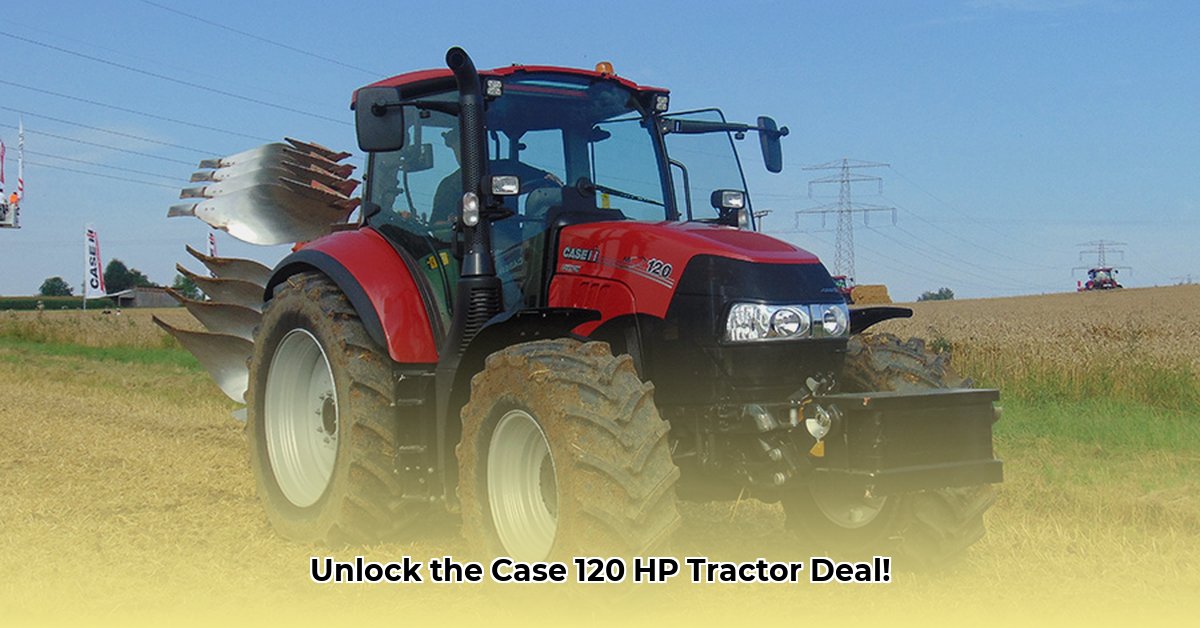
Finding the right used Case IH Farmall 120 tractor requires careful planning and research. This comprehensive guide equips you with the knowledge to make a smart purchase, ensuring you get the best possible deal on this reliable workhorse. We'll cover everything from understanding market variations to negotiating the best price and performing a thorough pre-purchase inspection. For even more information on similar models, check out this helpful resource: Case 130 Info.
Understanding the Case IH Farmall 120 HP Tractor Market
The Case IH Farmall 120 series (including the 120A and 120C models) enjoys strong popularity among farmers, striking a balance between power and affordability in the mid-range tractor segment. However, prices can vary significantly, depending on multiple factors. This understanding is critical to securing a favorable deal.
Key Price Influencers: A Detailed Look
Several factors significantly influence the price of a used Farmall 120:
Model Year and Condition: Newer models (e.g., 2023 or 2024) command higher prices. A well-maintained older tractor can be a smart buy, but be prepared for potential repairs. Condition is paramount.
Hours of Operation: Lower hours equate to less wear and tear, increasing value. Think of it like mileage on a car – lower is better.
Included Implements: Additional attachments such as a front-end loader, significantly improve the tractor's versatility and, therefore, its value.
Location: Regional differences in supply and demand dictate pricing. Conduct a broader geographic search to find better deals.
For instance, a 2021 120C might range from $48,000 to $85,000, highlighting the importance of thorough research. This guide will help you navigate these price variations.
Comparing Case 120A and 120C Models: Key Differences
Precise comparisons require access to detailed specifications. However, it's generally understood that the 120C model represents a newer generation, likely incorporating technological upgrades and feature enhancements over the 120A. This often translates to a higher price tag for the 120C. However, the condition of each specific tractor is paramount. A meticulously maintained 120A could outperform a neglected 120C.
Your Case 120 HP Tractor Buying Guide: A Step-by-Step Approach
Purchasing a used tractor is a substantial investment. This structured approach minimizes risk and maximizes your chances of securing a favorable deal:
Thorough Research: Begin by exploring online marketplaces like TractorHouse.com 1, analyzing price trends for different model years, conditions, and included implements in your region.
Budgeting: Determine a realistic budget, encompassing financing, potential repairs, and ongoing maintenance costs. Don't overextend yourself.
Pre-Purchase Inspection: This is non-negotiable. Engage a qualified mechanic or bring a knowledgeable friend to assess the tractor's condition thoroughly. Look for leaks, wear and tear, and overall mechanical soundness.
Test Drive: Operate the tractor to evaluate its performance, handling, and responsiveness. Listen for any unusual noises or vibrations.
Strategic Negotiation: Armed with research data, confidently negotiate the price based on the tractor's condition and market value. Be prepared to walk away if the price isn't right.
Documentation: Meticulously review all purchase agreements before signing. Ensure accuracy and clarity of all terms and conditions.
Aren't you curious about exactly how much a used Farmall 120 could cost in your area? Online resources will provide that answer.
Key Factors to Consider Before Purchasing
Operating Hours: Prioritize tractors with low operating hours; fewer hours generally signify less wear and tear.
Condition: A well-maintained tractor with a complete service history is a valuable asset; look for evidence of regular maintenance.
Included Implements: Assess the value added by any included implements (e.g., front-end loader).
Regional Pricing: Expand your search beyond your immediate area. You might uncover better deals in regions with lower demand or more motivated sellers. Don't limit your search!
Pre-Purchase Inspection: A Comprehensive Checklist
Before finalizing the purchase, perform a detailed inspection covering:
Engine: Check for leaks, unusual noises, and signs of wear and tear. Inspect oil levels and for any signs of overheating.
Hydraulics and Implements: Test all hydraulic functions and ensure implements (if included) operate smoothly.
Tires: Inspect tires for wear, damage, or uneven wear patterns.
Electrical System: Verify functionality of lights, gauges, and all electrical components.
Safety Features: Confirm that all safety features (seatbelts, lights, etc.) are in good working order.
Competitive Landscape: Comparing Tractor Brands
The Case IH Farmall 120 competes with similar models from John Deere, Massey Ferguson, and New Holland. A comprehensive comparison of features, reliability, parts availability, and price-to-performance ratios is crucial for informed decision-making.
Maintenance and Ownership Costs: Planning for the Future
The expense of owning a tractor extends beyond the initial purchase price. Factor in ongoing maintenance, repairs, and parts replacement; research average repair frequency and parts availability for Case 120 models to accurately project long-term costs. Regular maintenance is key to maximizing the tractor's lifespan.
Conclusion: Making a Smart Investment
Purchasing a Case IH Farmall 120—or any used tractor—requires careful planning and diligent research. This guide provides a framework for a successful transaction, helping you secure a reliable, well-maintained machine at a fair price. Remember, informed decision-making is key to a smart investment.